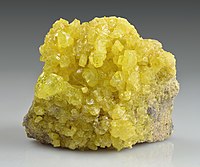
Photo from wikipedia
Lithium-sulfur (Li-S) batteries are candidates for next-generation energy storage systems because of their low cost, high theoretical specific capacity and safety. However, the serious lithium polysulfide (LiPS) shuttle effect leads… Click to show full abstract
Lithium-sulfur (Li-S) batteries are candidates for next-generation energy storage systems because of their low cost, high theoretical specific capacity and safety. However, the serious lithium polysulfide (LiPS) shuttle effect leads to a loss of reactive active substances and reduction of coulombic efficiency. In the current work, iron oxide (IO-700)-prepared by calcining a mixture of carbon spheres and ferric nitrate under an air atmosphere at 700 °C-was designed as a separator modifier to effectively adsorb LiPSs and accelerate the kinetics of the transformation of the intermediates, thereby inhibiting the shuttle effect. Li-S batteries including IO-700 showed long-term stability for 1000 cycles at 1C, with a capacity decay rate per cycle of only 0.0487%. A theoretical calculation indicated that, due to strongly polar active sites, Fe2O3 adsorbed LiPSs effectively to suppress the shuttle effect. This work has highlighted the importance for Li-S batteries of strongly polar active sites for anchoring LiPSs to inhibit the shuttle effect.
Journal Title: Chemical communications
Year Published: 2023
Link to full text (if available)
Share on Social Media: Sign Up to like & get
recommendations!